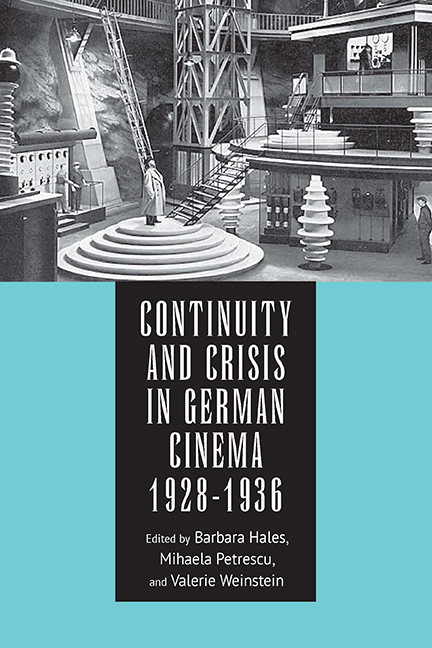Book contents
- Frontmatter
- Contents
- List of Illustrations
- Acknowledgments
- Introduction
- Part I Politics
- Part II The Economy
- Part III Concepts of Race and Ethnicity
- Part IV Genre Cinema
- Part V Making Cinema Stars
- Part VI Film Technologies
- Part VII German-International Film Relations
- Selected Bibliography
- Notes on the Contributors
- Index
2 - Film as Pedagogy in Late Weimar and Early Nazi Cinema: The Role of the Street in Mobilizing the Spectator
Published online by Cambridge University Press: 08 May 2021
- Frontmatter
- Contents
- List of Illustrations
- Acknowledgments
- Introduction
- Part I Politics
- Part II The Economy
- Part III Concepts of Race and Ethnicity
- Part IV Genre Cinema
- Part V Making Cinema Stars
- Part VI Film Technologies
- Part VII German-International Film Relations
- Selected Bibliography
- Notes on the Contributors
- Index
Summary
AS EARLY AS 1915, Hugo Münsterberg recognized the potential of moving images as educational tools for the masses, stating that “Millionen haben in den dunklen Häusern ihre Geographie, Geschichte und Naturwissenschaft gelernt” (millions have learned in the dark houses their geography and history and natural science). Yet, as Münsterberg acknowledges, “this power of the moving pictures to supplement the schoolroom and the newspaper and the library, is, after all, much less important than its chief task—to bring entertainment, and enjoyment and happiness to the masses.” When German cinema reached maturity during the 1920s, movie stars began to play a significant psychological role for spectators, providing them opportunities to identify with role models and their attitudes and actions. This psychological aspect is crucial, as it emphasizes film's function as an educational tool that showed audiences ways out of their miserable situations in the aftermath of the 1929 stock market crash. Not only did popular cinema and big-budget films entertain the masses in a time of political and social instability, but a number of German productions also offered guidance, stimulated sentiments, and ultimately generated politicized views among spectators.
This essay argues that key films in the transitional era at the end of the 1920s and in the early 1930s adhered to a formulaic pattern depicting a fragmented society at the outset, then proposing what filmmakers considered a righteous trajectory, or what I would call “the right path,” signaling a future marked by unity and wholeness. This pattern is present in Fritz Lang's serial-killer thriller M (1931), Slatan Dudow's proletarian drama Kuhle Wampe oder Wem gehört die Welt? (Kuhle Wampe or Who Owns the World?, English release, 1932), and Hans Steinhoff's Hitlerjunge Quex (Hitler Youth Quex, 1933), one of the earliest statesponsored feature films in the Third Reich. The shared trajectory from fragmentation to a new whole allowed for a surprisingly smooth transition from late Weimar to Nazi cinema, despite the alleged complete break between Weimar-era German culture and art propagated by the Nazis. I argue that the cinematic street, a dominant motif of Weimar cinema, assumed a key role in promoting the ideologies that were presented on screen: namely, it functioned as a crucial bridge between fragmentation at the outset of the film and a new whole at the end.
- Type
- Chapter
- Information
- Continuity and Crisis in German Cinema, 1928-1936 , pp. 51 - 70Publisher: Boydell & BrewerPrint publication year: 2016



